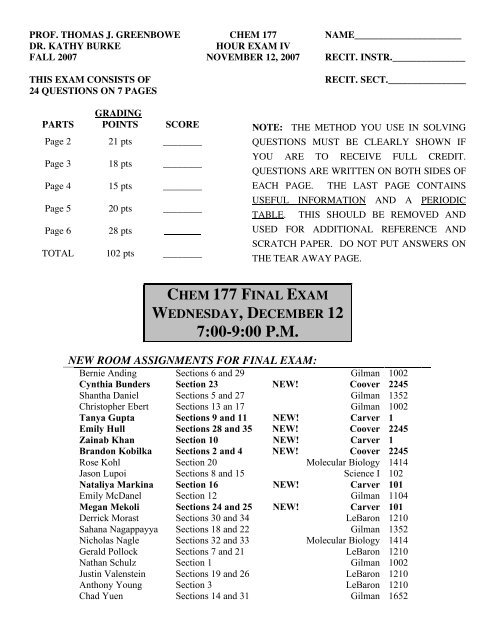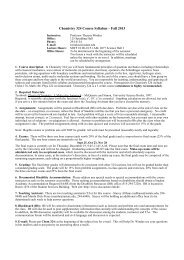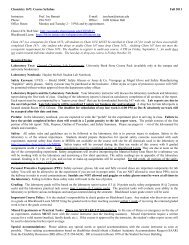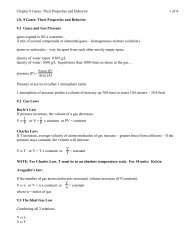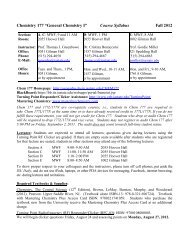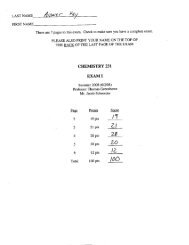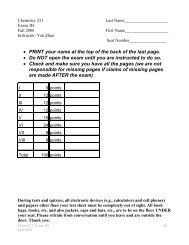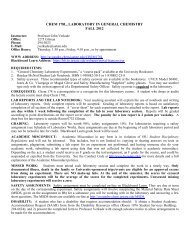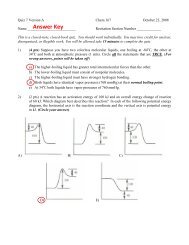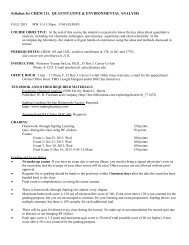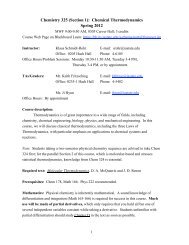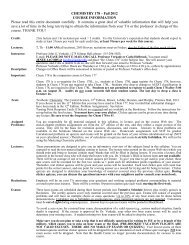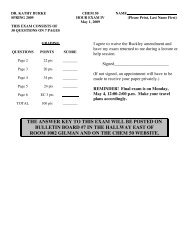Create successful ePaper yourself
Turn your PDF publications into a flip-book with our unique Google optimized e-Paper software.
PART I – Multiple Choice. (18 questions at 3 pts each = 54 pts total)1. Covalent bonding is aa) gain of electrons. c) transfer of electrons.b) loss of electrons. d) sharing of electrons.2. Which bond should have the longest length?a) N–N c) N≡Nb) N=N d) all three bond lengths should be about the same3. The average Cl–Cl bond energy is 243 kJ/mol. Therefore, the formation of a single bond betweenchlorine atomsa) should require the absorption of 243 kJ per mole of Cl 2 formed.b) should require the absorption of 486 kJ per mole of Cl 2 formed.c) should result in the release of 243 kJ per mole of Cl 2 formed.d) should result in the release of 486 kJ per mole ofCl 2 formed.4. The electronegativity for both sulfur and carbon is 2.5. Therefore, the compound CS 2 would beexpected to2a) be ionic with C as the anion. c) have nonpolar covalent bonds between C and S.b) be ionic with C as the cation. d) have polar covalent bonds between C and S.5. Which is the most acceptable electron dot structure for carbonyl fluoride, COF 2 ?CCOOa) F O F b) F O F c) F C F d) F CF6. Which molecule contains a triple bond?a) F 2 b) O 3 c) HCN d) H 2 CO7. Which of the following are allowed resonance forms of NCS – ?__I N C S and N C S_II N C S and N C S_III N C S and S C N__a) only I b) only II c) only III d) I and III
8. Assign formal charges to each atom in the resonance form for SOCl 2 given below.3OClSCla) 0 for Cl, 0 for S, and 0 for O c) -1 for Cl, +4 for S, and -2 for Ob) 0 for Cl, +1 for S, and -1 for O d) -1 for Cl, -2 for S, and -2 for O9. Two resonance forms for SOCl 2 are given below.OOClSClClSClIIIWhich is favored by the octet rule and which by formal charge considerations?a) I is favored by the octet rule and by formal charge considerations.b) I is favored by the octet rule and II by the formal charge considerations.c) II is favored by the octet rule and I by formal charge considerations.d) II is favored by the octet rule and by formal charge considerations.10. Consider a molecule with the following connections:OOH O C C O HWhen a valid electron dot structure is written, how many double bonds will the molecule contain?a) 0 b) 1 c) 2 d) 411. Which electron dot structure for OCN – has a formal charge of -1 on the most electronegative atom?a) N C O_b) N C O_c) N C O_d) N O C_12. The π bond in ethylene, CH 2 CH 2 , results from the overlap ofa) sp 3 hybrid orbitals d) sp 2 hybrid orbitalsb) s atomic orbitals e) p atomic orbitalsc) sp hybrid orbitals13. Which drawing represents a σ bonding molecular orbitals for a homonuclear diatomic molecule?a) b) c) d)
520. (4 pts) The MO diagram below is appropriate for B 2 . Based on this diagram, B 2a) has a bond order of one and is diamagnetic. c) has a bond order of two and is diamagnetic.b) has a bond order of one and is paramagnetic. d) has a bond order of two and is paramagnetic.!*2p!*2p2p!*2p!2p2p2p!*2p!2p2pE!2pE!2p2s!*2s2s2s!*2s2s! 2s! 2s1s!*1s1s1s!*1s1s! 1s! 1s21. (4 pts) The world record for lowest pressure at sea level was 652.5 mm Hg recorded inside TyphoonTip on October 12, 1979, in the Western Pacific Ocean. What is this pressure in atmospheres? Pleaseshow all work and all steps for full credit.22. (4 pts) A 0.750 L neon sign was filled neon gas at STP (T = 0.<strong>00</strong> ˚C, P = 1.<strong>00</strong> atm). How many gramsof Ne (g) were used? Please show all work and all steps for full credit.23. (4 pts) Draw two isomers of C 3 H 8 O. Draw correct Lewis structures for each.
24. (28 pts) For each chemical formula draw the Lewis structure, determine the number of regions of electron density around the central atom, draw a3-D structure showing the geometry, indicate the AXE notation, bond angles, write a word that describes the molecular geometry of the molecule,and indicate whether or not the molecule is polar. Water molecule is shown as an example.yes sp 3FormulaLewis Structure(include lone e – pairs)Regions ofElectronDensityAround theCentral AtomDraw a 3-D StructureShowing the MolecularGeometry(include lone e – pairs)Identify theMolecularGeometry(lone e – pairs aretransparent)AXE NotationandBond AnglesPolarMolecule(yes orno)Hybridizationof the CentralAtomH 2 O(sample)H OHO4 angular AX 2 E 2H H104.5˚a) SF 2b) AsH 3c) ClF 4–d) SeF 6
Increasing electronegativity1AH8A2.1 2A 3A 4A 5A 6A 7ALi BeB C N O FIncreasing electronegativity1.0Na0.9K0.8Rb0.8Cs1.5Mg1.2 3B 4B 5B 6B 7B (------8B------) 1B 2BCa Sc Ti V Cr Mn Fe Co Ni Cu Zn1.0 1.3Sr Y1.0Ba1.2La-Lu1.5 1.6 1.6 1.5 1.8Zr Nb Mo Tc Ru1.4 1.6 1.8Hf Ta W1.9 2.2Re Os1.9Rh2.2Ir1.9Pd2.2Pt1.9 1.6Ag Cd1.9 1.7Au Hg2.0Al1.5Ga1.6In1.7Tl2.5Si1.8Ge1.8Sn1.8Pb3.0P2.1As2.0Sb1.9Bi3.5S2.5Se2.4Te2.1Po4.0Cl3.0Br2.8I2.5At0.7Fr0.9Ra1.0-1.21.31.51.71.92.22.22.22.41.91.81.91.92.02.20.70.9c = 3.<strong>00</strong> × 10 8 ms –11 J = 1 kg m 2 s –24.18 J/g ˚C1 N = 1 kg• m/s 21 Pascal = 1 N/m 2dRTP= molar massP 1V 1nT 1= P 2 V 2nT 2R = 0.082 L•atm/K•mol760 torr = 1 atm = 760 mmHgAvogadro’s Number = 6.02 × 10 231 atm = 1.01 × 10 2 kP a = 760 torrSTP (0.0 ˚C 1.0 atm)1A11H1.013Li6.9411Na23.019K39.137Rb85.555Cs13387Fr(223)2A24Be9.0112Mg24.320Ca40.138Sr87.656Ba13788Ra2263B321Sc45.039Y88.957La13989Ac2274B422Ti47.940Zr91.272Hf178104Rf(261)LanthanidesActinides5B523V50.941Nb92.973Ta181105Db(262)58Ce14090Th2326B624Cr52.042Mo95.974W184106Sg(263)59Pr14191Pa231Periodic Table of the Elements7B725Mn54.943Tc(98)75Re186107Bh(262)60Nd14492U238826Fe55.844Ru10176Os190108Hs(265)61Pm(145)93Np(237)8B927Co58.945Rh10377Ir192109Mt(266)62Sm15094Pu(244)1028Ni58.746Pd10678Pt195110Ds(281)63Eu15295Am(243)1B1129Cu63.547Ag10879Au19764Gd15796Cm(247)2B1230Zn65.448Cd11280Hg20165Tb15997Bk(247)3A135B10.813Al27.031Ga69.749In11581Tl20466Dy16298Cf(251)4A146C12.014Si28.132Ge72.650Sn11982Pb20767Ho16599Es(252)5A157N14.015P31.033As74.951Sb12283Bi20968Er1671<strong>00</strong>Fm(257)6A168O16.016S32.134Se79.052Te12884Po(209)69Tm169101Md(258)7A179F19.017Cl35.535Br79.953I12785At(210)70Yb173102No(259)8A182He4.<strong>00</strong>10Ne20.218Ar39.936Kr83.854Xe13186Rn(222)71Lu175103Lr(260)


